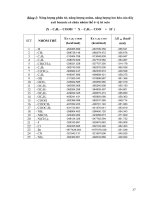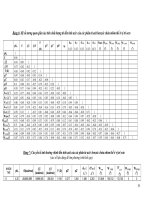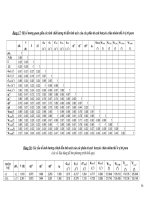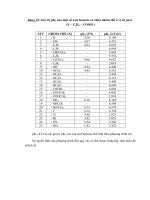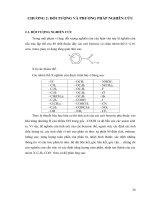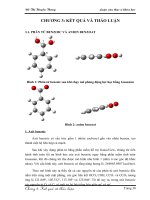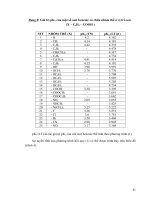The effect of sulphuric acid activation on the crystallinity, surface area, porosity, surface acidity, and bleaching power of a bentonite
Bạn đang xem bản rút gọn của tài liệu. Xem và tải ngay bản đầy đủ của tài liệu tại đây (471.86 KB, 8 trang )
Food
Chemistry
Food Chemistry 105 (2007) 156–163
www.elsevier.com/locate/foodchem
The effect of sulphuric acid activation on the crystallinity, surface
area, porosity, surface acidity, and bleaching power of a bentonite
¨ nal b, Yu¨ksel Sarıkaya b,*
Hu¨lya Noyan a, Mu¨ßs erref O
b
a
Refik Saydam Hygiene Center (RSHC), Sıhhiye, Ankara, Turkey
Ankara University, Faculty of Science, Department of Chemistry, Besßevler, 06100 Ankara, Turkey
Received 6 December 2006; received in revised form 22 March 2007; accepted 26 March 2007
Abstract
The Hancßılı (Keskin, Ankara, Turkey) bentonite was activated with H2SO4 by dry method at 97 °C for 6 h to obtain optimum parameters for imparting a maximum bleaching power towards soybean oil. The H2SO4 content in dry bentonite-acid mixture was changed
between 0% and 70%. The natural and activated samples were examined by X-ray diffraction (XRD), N2 adsorption–desorption, and
n-butylamine adsorption (from the solution in cyclohexane). The specific surface area (S), specific micro–mesopore volume (V), mesopore size distribution (PSD), and surface acidity (nm) of the samples were determined. The bleaching power (BP) of each sample for
alkali-refined soybean oil was determined. The S, V, nm, and BP increase after activation at various acid contents up to 40% H2SO4 without any considerable change in crystal structure of the smectite. The BP is controlled more by the PSD rather than other adsorptive
properties of the bleaching earth. The optimum parameters for activation to obtain maximum bleaching power, are H2SO4% = 50–
60, S = 250–230 m2 gÀ1, V = 0.46–0.47 cm3 gÀ1, nm = 9.0 Â 10À4–8.4 Â 10À4 mol gÀ1 and PSD mainly distributed between 1.4 and
6.0 nm.
Ó 2007 Elsevier Ltd. All rights reserved.
Keywords: Acid activation; Bentonite; Bleaching; Porosity; Surface acidity; Surface area
1. Introduction
Besides numerous industrial application areas, bentonites and their major clay mineral smectites have been used
in food technology such as bleaching earth, clarification of
beer and wine, animal feed bond, and food additives (Grim
& Gu¨ven, 1978; Murray, 1991, 2000). Bentonites may also
contain other clay- and non-clay minerals as impurities.
Smectites generally are 2:1 layered, hydrated aluminum silicates. Bentonites are treated by the inorganic acids such as
HNO3, HCl and H2SO4 to remove some of the impurities
and thereby to obtain more adsorptive materials (Heyding,
Ironside, Norris, & Pryslazniuk, 1960; Komadel, 2003;
Komadel et al., 1996; Komadel, Schmidt, Madejova´, &
*
Corresponding author. Tel.: +90 312 2126720/1014; fax: +90 312
2232395.
E-mail address: (Y. Sarıkaya).
0308-8146/$ - see front matter Ó 2007 Elsevier Ltd. All rights reserved.
doi:10.1016/j.foodchem.2007.03.060
ˇ icˇel, 1990; Mills, Holmes, & Cornelius, 1950; Van RomC
paey, Van Ranst, De Coninck, & Vindevogel, 2002). Due
to their widespread use in edible oil bleaching, the activated
bentonites are called as bleaching earths (Beneke & Lagaly,
2002; Boukerroui & Ouali, 2000; Christidis, Scott, & Dunham, 1997; Griffiths, 1990; Siddiqui, 1968; Tsai, Chang,
Lai, & Lo, 2005).
Crude edible oils obtained by solvent extraction or
compression from plants such as soybean, safflower, sunflower, corn, cottonseed, rapeseed, mustard seed, sesame,
palm, peanut, coconut and olive, can be processed by
chemical or physical refining techniques (Mounts,
1981). The conventional chemical technique consists of
water or acid degumming, caustic refining, deodorization,
and winterization steps. Besides color pigments, other
impurities such as soap, sulphur, phosphates, trace metals, and oxidation products are removed from the
alkali-refined oils by bleaching (Falaras, Kovanis, Lezou,
H. Noyan et al. / Food Chemistry 105 (2007) 156–163
& Seiragakis, 1999; Kheok & Lim, 1982; Morgan, Shaw,
Sidebottom, Soon, & Taylor, 1985; Oboh & Aworh,
1988; Rossi, Gianazza, Alamprese, & Stanga, 2003;
Temuujin et al., 2006; Zschau, 2001). Bleaching is based
on the physical adsorption, chemical adsorption, ion
exchange, and chemical decomposition of coloring
organic pigments and other impurities on the bleaching
earth.
Like other adsorptive solids, the pores of a bleaching
earth may be micropores (width <2 nm), mesopores (width
2–50 nm) and macropores (width >50 nm) (Gregg & Sing,
1982). The radius of a pore, assumed to be cylindrical, can
be taken as half the pore width. The total volume of pores
in 1 g of solid is defined as the specific pore volume (V).
The area of the inner and outer walls of the pores located
intra- and interparticles in 1 g solid is taken as the specific
surface area (S). The adsorptive surface originates from the
micro- and mesopores. The contribution of macropores on
the surface area is negligible. Furthermore, bleaching
earths behave as solid acids. Bro¨nsted and Lewis acid sites
on their surfaces are proton donors and electron pair
acceptors, respectively (Brown & Rhodes, 1997a; Frenkel,
¨ nal, &
1974; Kumar, Jasra, & Bhat, 1995; Noyan, O
Sarıkaya, 2006; Walling, 1950). The molar number of acid
sites in 1 g solid is defined as surface acidity (nm). The acid
strength of a surface can be characterized by the equilibrium constant (K) of its neutralization reaction with a weak
base such as ammonia, and amines (Benesi, 1956, 1957;
Brown & Rhodes, 1997b; Loeppert, Zelazny, & Volk,
1986).
Bleaching power is dependent on the surface area, surface acidity, catalytic activity, porosity and pore size distribution of the bleaching earth (Boki, Kubo, Wada, &
Tamura, 1992; Boki, Kubo, Kawasaki, & Mori, 1992;
Breen, Zahoor, Madejova´, & Komadel, 1997; Gonza´lezParadas, Villafranca-Sa´nchez, & Gallego-Campo, 1993;
¨ nal, submitted for publication; O
¨ nal, Sarıkaya, AlemdO
arog˘lu, & Bozdog˘an, 2002; Srasra, Bergaya, Van Damme,
& Ariguib, 1989; Vicente-Rodriquez, Suarez, Lopez-Ganza´lez, & Ba´nares-Munoz, 1996). These physicochemical
properties of bleaching earths change depending on the
mineralogical and chemical composition of the activated
bentonite, type and concentration of the inorganic acid,
used in the process and also temperature and time of
activation.
The bleaching power of an acid-activated bentonite is
generally examined on the basis of the b-carotene and chlorophyll adsorption capacities (Gonza´lez-Paradas, Villafranca-Sa´nchez, Socias-Viciana, & Gallego-Campo, 1994;
Khoo, Morsingh, & Liew, 1979; Liew, Tan, Morsingh, &
Khoo, 1982; Mokaya, Jones, Davies, & Whittle, 1993;
Sarıer & Gu¨ler, 1988, 1989). The adsorption mechanism
has been discussed by using both the Langmuir and Freundlich isotherms (Sabah, C
¸ ınar, & C
¸ elik, 2007; Topallar,
1998; Tsai, Chang, Ing, & Chang, 2004; Teng & Lin,
2006). The kinetics of the bleaching process has been examined on the basis of a first order reaction model applied to
157
chemical reactions (Brimberg, 1982; Christidis & Kosiari,
2003).
Although several workers mentioned above have made
extensive studies on the numerous properties of bleaching
earths and bleaching processes, no report specifically concentrated on the surface properties of bleaching earths
has yet appeared. The aim of this study is to examine of
the bleaching power of some H2SO4-treated bentonite samples by making use of surface area, surface acidity, porosity
and mesopore size distribution parameters.
2. Materials and methods
2.1. Materials
A calcium-rich bentonite (CaB) sample from the Hancßılı
bed (Keskin, Ankara, Turkey) was used in the experiments.
The effects of heating and acid activation on some physicochemical properties of this material were previously inves¨ nal, & Sarıkaya, in press, submitted for
tigated (Noyan, O
publication). The bulk chemical analysis of the bentonite
(mass %) is SiO2, 60.85; TiO2, 0.85; Al2O3, 16.50; Fe2O3,
5.74; MgO, 2.71; CaO, 2.37; Na2O, 1.53; K2O, 0.83 and
loss on ignition (LOI), 8.40. The H2SO4 (98%,
d = 1.98 g cmÀ3) and other chemicals used are of analytical
grade and were supplied from Merck Chemical Company.
The bentonite was ground to pass through a 0.074 mm
(200 mesh) sieve, dried at 105 °C for 24 h, and stored in
tightly closed plastic bottles for use in the experiments.
Alkali-refined soybean oil used in the bleaching experiments was supplied from a vegetable oil plant (Marsa,
_
Istanbul,
Turkey).
2.2. Acid activation
Eleven samples, each having a mass of 40 g, were
weighed from the dried bentonite powder. The samples
were activated with H2SO4 by dry method (Heyding
et al., 1960). The content of H2SO4 in dry bentonite-acid
mixture was changed between 0% and 70% by mass. Acid
content was increased in smaller increments around 40%
H2SO4, the likely optimum rate by experience. Eleven
gel-like mixtures were prepared by adding the concentrated acid having calculated amounts of H2SO4. Acid
activation was conducted by heating the mixtures in an
oven at 97 °C for 6 h. Each activated sample was suspended in water, and centrifuged. Obtained precipitate
was washed with distilled water until it was free from
SO2À
against 5% BaCl2 solution. After drying at 105 °C
4
for 4 h, the activated samples were stored in tightly closed
plastic bottles. In this way, eleven bleaching earths were
¨ nal
obtained. Prior experience (Noyan et al., 2006; O
¨ nal & Sarıkaya, 2007) with same and other
et al., 2002; O
bentonites indicates that the physicochemical properties of
acid treated bentonite samples do not differ appreciably
from batch to batch. Therefore, acid treatment procedures
were done once.
158
H. Noyan et al. / Food Chemistry 105 (2007) 156–163
2.3. Instrumentation
3. Result and discussion
The X-ray diffraction (XRD) patterns of natural and
acid activated samples were recorded from random mounts
prepared by glass slide method using a Rikagu D-Max
2200 Powder Diffractometer, operating at 40 kV and
30 mA, using Ni-filtered CuKa radiation having 0.15418
nm wavelength, at a scanning speed of 2°2h minÀ1 (Moore
& Reynolds, 1997).
The adsorption and desorption isotherms of N2, at
liquid N2 temperature, on the natural and acid activated
samples were determined by a volumetric adsorption
instrument of pyrex glass connected to a high vacuum sys¨ nal, Baran, &
tem (Sarıkaya & Aybar, 1978; Sarıkaya, O
Alemdarog˘lu, 2000; Sarıkaya, Sevincß, & Akıncß, 2001).
Before measurements, the samples were outgassed at
150 °C for 4 h under a vacuum of 10À3 mm Hg. The technique of gas adsorption manometry was used for the determination of the adsorbed amount (Rouquerol, Rouquerol,
& Sing, 1999; Sing, 2001). This point-by-point procedure is
based on the measurement of the gas pressure in a calibrated constant volume at a known temperature. Pre-calibrated dosing volume at dead space volume on the
adsorbent bulb was kept constant by the pressure measurements with mercury manometers. Pressure of dosing chamber was measured at room temperature before and after
nitrogen allowed to enter adsorbent bulb. Dead space pressure, which is also equilibrium pressure of adsorption, was
measured for each point. The amount adsorbed was calculated for each point by evaluating the known parameters.
For each point, the cumulative amount of the adsorbed
nitrogen until equilibrium pressure was reached, has been
taken as the attained adsorption capacity.
The adsorption of n-butylamine, from a cyclohexanesolution, on the natural and acid-activated samples was
recorded by a UV–VIS spectrophotometer (Varian, Cary
50). In each experiment, a series of 10 mL test tubes was
loaded with 0.1 g of bentonite sample. Then, to each tube,
10 mL of freshly prepared n-butylamine solutions (in cyclohexane) with a concentration ranging from 2.0 Â 10À3 M
to 1.8 Â 10À2 M were pipetted. To reach adsorption equilibrium, the tubes were shaken mechanically at 25 °C for
75 h. The absorbance values of the solutions were then
measured at the wavelength of maximum absorption,
k = 227 nm, and equilibrium concentrations were determined from a calibration plot.
Each bleaching experiment was carried out in an open
400 mL beaker containing a stirred suspension of a 1% by
mass bleaching earth in alkali-refined soybean oil. The mixture was then heated to 95–105 °C, kept at this temperature
interval for 15 min, similar to the standard AOCS proce¨ nal, submitted for
dures (Chamkasem & Johnson, 1988; O
publication). The oil was than filtered through Whatman
No. 41 filter paper. The color index of the oil, in red-yellow
units, was determined by using a Lovibond Automatic Tintometer (Type D) equipped with 2.54 cm cells according to
the AOCS Official Method Cc 13b-45 (1973).
3.1. XRD analysis
The XRD powder-patterns for some representative
bentonites, natural and acid-activated, are given in Fig. 1.
The bentonite investigated displays peaks belonging to
the clay mineral smectite (with a d0 0 1 value of 1.49 nm),
and non-clay minerals, quartz, opal, and feldspar. Characteristic XRD peaks were identified according to the literature (Moore & Reynolds, 1997). The XRD patterns show
that the crystallinity of the smectite decreases when the
mass-percentage of H2SO4 in the acid treatment exceeds
10%. However, the crystal structure of the smectite is still
partly preserved even after activation with a H2SO4 content
of 50% by mass. The crystallinity of the non-clay minerals
are not affected by the acid activation process.
3.2. Nitrogen adsorption and desorption isotherms
The N2 adsorption/desorption isotherms at the liquid
N2 temperature ($77 K) for natural and all acid-activated
samples were examined, and representative ones, for natural and acid-activated samples are shown in Fig. 2. Here, p
is the adsorption and desorption equilibrium pressure, p0 is
the vapor pressure of bulk liquid nitrogen at experimental
temperature, p/p0 = x is the relative equilibrium pressure,
and n is the adsorption capacity defined as the number of
moles of nitrogen adsorbed on 1 g of sample at any x.
Fig. 1. XRD patterns of natural bentonite and some acid activated
samples (S: smectite, Q: quartz, O: opal, F: feldspar).
H. Noyan et al. / Food Chemistry 105 (2007) 156–163
159
treated (50–70% H2SO4) bentonite is discernible under a
relative pressure of x ffi 0.2 while, with the natural material,
capillary condensation can only occur at x = 0.4.
3.3. Surface area
The specific surface areas of the samples were obtained
from the standard Brunauer, Emmett and Teller (BET)
method by using the adsorption data of N2 in the interval
0.05 < x < 0.35 (Brunauer, Emmett, & Teller, 1938; Everett, Parfitt, Sing, & Wilson, 1974; McClellan & Hornsberger, 1967; Sarıkaya, Ada, Alemdarog˘lu, & Bozdog˘an,
2002). The representative BET plots were given in Fig. 3.
These plots fit to the BET equation in the form
x=nð1 À xÞ ¼ 1=nm x þ ½ðc À 1Þ=nm cx
ð1Þ
where, nm is the monomolecular adsorption capacity and c
is a constant. The values nm and c were determined by solving the simultaneous equations obtained from the slope
and intercept of the BET straight line. The specific surface
areas, S/m2 gÀ1, were calculated from the equation
ð2Þ
S ¼ nm N A am
À23
Fig. 2. Adsorption/desorption isotherms of N2 at liquid N2 temperature
for natural bentonite and some acid activated samples.
The isotherms show that the adsorption capacity increases
with increasing acid content up to 50% H2SO4 and than
decreases slowly through 70% H2SO4.
According to Brunauer, the classification of these isotherms is similar to Type II (Brunauer, Deming, Deming,
& Teller, 1940). The shapes of the adsorption/desorption
isotherms indicate that the prepared bleaching earths are
mainly mesoporous solids but also contain some micropores. The overlapping of the adsorption desorption isotherms over the interval 0.35 < x < 0 shows that the
multimolecular and monomolecular adsorptions are
reversible. After multimolecular adsorption was complete
at x = 0.35, capillary condensation begins, and all mesopores filled up to x = 0.96. Bulk liquid nitrogen forms at
x = 1 (Linsen, 1970). At the interval of 1 < x < 0.96, the
liquid nitrogen outside the mesopores evaporates spontaneously so long as the relative equilibrium pressure due to
desorption is low enough. The same is true for the liquid
nitrogen within the mesopores at the interval,
0.96 < x < 0.35. The shapes of mesopores in a solid may
be of cylindrical-, parallel-sides-, slit-, and wedge-shaped
or like an ink-bottle. Capillary condensation begins in the
narrowest mesopores first, while capillary evaporation
starts earlier in the largest mesopores. This difference is
the major cause of the hysteresis between adsorption and
desorption isotherms. The hysteresis phenomenon becomes
more prominent with acid activation because the amount
of mesopores increases by the structural deformation.
Due to the same reason, capillary condensation on acid-
À1
where, NA = 6.02 Â 10
mol is the Avogadro constant
and am = 16.2 Â 10À20 m2 is the area occupied by a single
nitrogen molecule.
As seen in Fig. 3, the slope of BET straight lines
decreases up to 50% H2SO4 and then tends to increase
slightly up to 70% H2SO4. A reverse behavior is also
reflected in the surface area versus acid content plots
(Fig. 4). As seen in Fig. 4, the S value increases rapidly
from 25 m2 gÀ1 to its maximum value of 285 m2 gÀ1 as
the acid content increases from zero to 40–45% H2SO4,
and then decreases slowly.
3.4. Micro–mesopore volume
All micro- and mesopores are full with liquid nitrogen
by desorption at x = 0.96, as mentioned above. Hence,
Fig. 3. BET plots for natural bentonite and some acid activated samples.
160
H. Noyan et al. / Food Chemistry 105 (2007) 156–163
Fig. 4. Variation of the specific surface area (S) and the specific micro–
mesopore volume (V) with the H2SO4 content in activation.
the adsorption capacities as liquid nitrogen volumes estimated from desorption isotherms at x = 0.96 are taken as
the specific micro–mesopore volumes, V/cm3 gÀ1, of the
samples.
The variation of the micro–mesopore volume with the
H2SO4 content used in activation is shown in Fig. 4. The
V value increases rapidly from 0.05 cm3 gÀ1 to 0.45 cm3 gÀ1
as the acid content changes from zero to 50% H2SO4, and
then stays approximately constant. The S and V curves do
not change parallel as seen in Fig. 4. The increase in porosity is due to the partial dissolution of the exchangeable cations such as Na+ and Ca2+, and also structural cations
such as Al3+, Fe3+, and Mg2+ from 2:1 layers of the smectite mineral.
3.5. Pore size distribution
The pore size distributions (PSD) of the samples were
obtained and representative curves are given in Fig. 5.
Here, r is the radius of the mesopores (assumed to be cylindrical) and V is the specific micro–mesopore volume. The r
values were calculated from desorption isotherms by using
corrected Kelvin equation which is a relationship between r
¨ nal & Sarıkaya, 2007).
and x values (Gregg & Sing, 1982; O
The V values corresponding to r values were also calculated
from the desorption isotherms as the liquid nitrogen volumes for each x. The area under the PSD curve and two
known abscissa values is related to the relative amount of
mesopores having sizes that fall into the range defined by
the abscissa limits. The most abundant approximate pore
size increases from 1.84 to 2 nm up to 50% H2SO4, probably due to the transformation of some micropores to mesopores during the development of the activation. Seventy
percent of H2SO4 sample has two maxima at 1.84 and
2.68 nm. On the other hand, the area of the PSD curve
increases with increasing acid content as seen in Fig. 5.
After the 50% acid content, all samples have maximum r
Fig. 5. Mesopore size distribution (PSD) curves of some acid activated
samples.
values and the area of PSD curves display a slight increase.
This indicates that the rate of transformation of micropores to mesopores decreases. So the rapid increases in the
S and V values decreases by the activation above the
50% H2SO4 as seen in Fig. 4.
3.6. Surface acidity
The average surface acidity (nm/mol gÀ1) of each sample
was determined from three Langmuir plots drawn by using
the data obtained from n-butylamine adsorptions (Brown
& Rhodes, 1997a; Noyan et al., 2006; Varma, 2002). The
surface acidity versus the H2SO4 content is shown in
Fig. 6. The nm value increases rapidly from 4.2 Â 10À4 to
9.4 Â 10À4 mol gÀ1 with an increase of the acid content
from zero to 45% H2SO4. The result shows that the surface
acidity and surface area change parallel to each other by
the activation.
3.7. Bleaching power
Bleaching or decolorizing power (BP) of the bleaching
earths was calculated from the equation;
BP ¼ 100ðR0 À RÞ=R0
ð3Þ
where, R0 and R are the red color units on Lovibond scale
of the alkali-refined oil before and after bleaching. The variation of the BP with the H2SO4 content is seen in Fig. 6.
The BP value increases rapidly from 3 to 70 with an increase of the acid content from zero to 50–60% H2SO4,
H. Noyan et al. / Food Chemistry 105 (2007) 156–163
161
porosity and surface acidity, it depends more on the mesopore size distribution of the bleaching earth. The bleaching
earths obtained by acid activation are more porous materials than the natural bentonite for use as adsorbents, filtering medium, catalyst and precursors for pillared clays.
Acknowledgements
The authors thank the Scientific Research Council of
Ankara University, Turkey for supporting this study under
a Project No: 2003.07.05.082.
References
Fig. 6. Variation of the surface acidity (nm) and the bleaching power (BP)
by increasing H2SO4 content in activation.
and then decreases slowly. Although the changes in the S,
V, nm, and BP are similar until up to the 40% H2SO4, their
maxima do not exactly overlap. However, the BP does not
have a maximum when S, V, and nm reach to their maxima.
The BP reaches to a maximum at the optimum conditions,
i.e., 50–60% H2SO4, S = 250–230 m2 gÀ1, V = 0.46–0.47
cm3 gÀ1, and nm = 9.0 Â 10À4–8.4 Â 10À4 mol gÀ1. The
maximum BPs of this bleaching earth and commercial
Tonsil 131 (Su¨d Chemie) are comparable as 0.71 and
0.69, respectively. This shows that bleaching earth prepared under optimum conditions is suitable for industrial
uses. With an acid content of 50%, the area of the PSD
curve reaches a maximum value and r is fit to the sizes of
pigments as seen in Fig. 5. The large-size, colored organic
pigments in the soybean oil can penetrate into the mesopores with a radius between 1.4 and 3.0 nm and strongly adsorbed on their surface. However, the BP is mainly
controlled by the PSD, rather than the other adsorptive
properties.
As to oil retention characteristics of the natural and
acid-activated bentonites, the natural material is found to
have trapped some mass of oil roughly 20% of its own
weight after use, whereas, after acid-activation, the relative
mass of oil increases up to 40%. In summary, oil retainment property increases as the acid content in activation
increases, but never exceeds 40%.
4. Conclusion
The exchangeable, and to a lesser extent, structural cations of the smectite in a bentonite are removed by acid activation. The surface area, micro–mesopore volume,
mesopore size distribution, surface acidity and bleaching
power of a bentonite are greatly affected from acid activation at limited acid contents without any considerable
change in crystal structure of the smectite. Although, the
bleaching power increases with increasing surface area,
AOCS (1973). Official method Cc 13b-45 color determination by tintometer. Journal of the American Chemical Society.
Beneke, K., & Lagaly, G. (2002). From fuller’s earth to bleaching earth: A
historical note. ECGA (European Clay Group Association) Newsletter,
5, 57–78.
Benesi, H. A. (1956). Acidity of catalyst surfaces. I. Acid strength from
colors of adsorbed indicators. The Journal of the American Chemical
Society, 78, 5490–5494.
Benesi, H. A. (1957). Acidity of catalyst surfaces. II. Amine titration using
Hammett indicators. The Journal of Physical Chemistry, 61, 970–973.
Boki, K., Kubo, M., Kawasaki, N., & Mori, H. (1992). Adsorption
isotherms of pigments from alkali-refined vegetable oils with clay
minerals. Journal of the American Oil Chemists Society, 69, 372–378.
Boki, K., Kubo, M., Wada, T., & Tamura, T. (1992). Bleaching of alkalirefined vegetable oils with clay minerals. Journal of the American Oil
Chemists Society, 69, 233–236.
Boukerroui, A., & Ouali, M. S. (2000). Regeneration of a spent bleaching
earth and its reuse in the refining of an edible oil. Journal of Chemical
Technology and Biotechnoogy, 75, 773–776.
Breen, C., Zahoor, E. D., Madejova´, J., & Komadel, P. (1997).
Characterization and catalytic activity of acid-treated size-fractionated
smectites. The Journal of Physical Chemistry B, 101, 5324–5331.
Brimberg, U. I. (1982). Kinetics of bleaching of vegetable oils. Journal of
the American Oil Chemists Society, 59, 74–78.
Brown, D. R., & Rhodes, C. N. (1997a). Bronsted and Lewis acid catalysis
with ion-exchanges clays. Catalysis Letters, 45, 35–40.
Brown, D. R., & Rhodes, C. N. (1997b). A new technique for measuring
surface acidity by ammonia adsorption. Thermochimica Acta, 294,
33–37.
Brunauer, S., Deming, L. S., Deming, D. M., & Teller, E. (1940). On a
theory of the van der Waals adsorption on gases. Journal of the
American Chemical Society, 62, 1723–1732.
Brunauer, S., Emmett, P. H., & Teller, E. (1938). Adsorption of gases in
multimolecular layers. Journal of the American Chemical Society, 60,
308–319.
Chamkasem, N., & Johnson, L. A. (1988). Color stability of glandless
cottonseed oil. Journal of the American Oil Chemists Society, 65,
1778–1780.
Christidis, G. E., & Kosiari, S. (2003). Decolorization of vegetable oils: a
study of the mechanism of adsorption of b-carotene by an acidactivated bentonite from Cyprus. Clays and Clay Minerals, 51,
327–332.
Christidis, G. E., Scott, P. W., & Dunham, A. C. (1997). Acid activation
and bleaching capacity of bentonites from the island of Milos and
Chios, Aegean, Greece. Applied Clay Science, 12, 329–347.
Everett, D. H., Parfitt, G. D., Sing, K. S. W., & Wilson, R. (1974). The
SCI/IUPAC/NPL project on surface area standards. Journal of
Applied Chemistry and Biotechnology, 24, 199–219.
Falaras, P., Kovanis, I., Lezou, F., & Seiragakis, G. (1999). Cottonseed oil
bleaching by acid-activated montmorillonite. Clay Minerals, 34,
221–232.
162
H. Noyan et al. / Food Chemistry 105 (2007) 156–163
Frenkel, M. (1974). Surface acidity of montmorillonites. Clays and Clay
Minerals, 22, 435–441.
Gonza´lez-Paradas, E., Villafranca-Sa´nchez, M., & Gallego-Campo, A.
(1993). Influence of the physical–chemistry properties of an acid
activated bentonite in the bleaching of olive oil. Journal of Chemical
Technology and. Biotechnology, 57, 213–216.
Gonza´lez-Paradas, E., Villafranca-Sa´nchez, M., Socias-Viciana, M., &
Gallego-Campo, A. (1994). Adsorption chlorophyll from acetone
solution on natural and activated bentonite. Journal of Chemical
Technology and. Biotechnology, 61, 175–178.
Gregg, S. J., & Sing, K. S. W. (1982). Adsorption, surface area and porosity
(2nd ed.). London: Academic Press.
Griffiths, J. (1990). Acid activated bleaching clays. Industrial Minerals,
276, 55–67.
Grim, R. E., & Gu¨ven, N. (1978). Bentonites – geology, mineralogy,
properties and uses. Developments in Sedimentology (Vol. 24). New
York: Elsevier.
Heyding, R. D., Ironside, R., Norris, A. R., & Pryslazniuk, R. Y. (1960).
Acid activation of montmorillonite. Canadian Journal of Chemistry,
38, 1003–1016.
Kheok, S. C., & Lim, E. E. (1982). Mechanism of palm oil bleaching by
montmorillonite clay activated at various acid concentrations. Journal
of the American Oil Chemists Society, 59, 129–131.
Khoo, L. E., Morsingh, F., & Liew, K. Y. (1979). The adsorption of bcarotone. I. By bleaching earths. Journal of the American Oil Chemists
Society, 59, 672–675.
Komadel, P. (2003). Chemically modified smectites. Clay Minerals, 38(11),
127–138.
Komadel, P., Madejova´, J., Janek, M., Gates, W. P., Kirkpatrick, R. J., &
Stucki, J. W. (1996). Dissolution of hectorite in inorganic acids. Clays
and Clay Minerals, 44(2), 228–236.
ˇ icˇel, B. (1990). Alteration of
Komadel, P., Schmidt, D., Madejova´, J., & C
smectites by treatments with hydrochloric acid and sodium carbonate
solutions. Applied Clay Science, 5, 113–122.
Kumar, P., Jasra, R. V., & Bhat, T. S. G. (1995). Evolution of porosity
and surface acidity in montmorillonite clay on acid activation.
Industrial and Engineering Chemistry Research, 34, 1440–1448.
Liew, K. Y., Tan, S. H., Morsingh, F., & Khoo, L. E. (1982). Adsorption
of b-carotene: II. On cation exchanged bleaching clays. Journal of the
American Oil Chemists Society, 59, 480–484.
Linsen, B. G. (1970). Physical and chemical aspects of adsorbents and
catalysts. London: Academic Press.
Loeppert, R. H., Zelazny, L. W., & Volk, B. G. (1986). Acidic properties
of montmorillonite in selected solvents. Clays and Clay Minerals, 34,
87–92.
McClellan, A. L., & Hornsberger, H. F. (1967). Cross-sectional areas of
molecules adsorbed on solid surfaces. Journal of Colloid and Interface
Science, 23, 577–599.
Mills, G. A., Holmes, J., & Cornelius, E. B. (1950). Acid activation of
some bentonite clays. Journal of Physics and Colloid Chemistry, 54,
1170–1185.
Mokaya, R., Jones, W., Davies, M. E., & Whittle, M. E. (1993).
Chlorophyll adsorption by alumina-pillared acid activated clays.
Journal of the American Oil Chemists Society, 70, 241–244.
Moore, D. M., & Reynolds, R. C. Jr., (1997). X-ray diffraction identification and analysis of clay minerals (2nd ed.). Oxford: Oxford
University Press.
Morgan, D. A., Shaw, D. B., Sidebottom, T. C., Soon, T. C., & Taylor, R.
S. (1985). The function of bleaching earths in the processing of palm
kernel and coconut oils. Journal of the American Oil Chemists Society,
62, 292–299.
Mounts, T. L. (1981). Chemical and physical effects of processing fats and
oils. Journal of the American Oil Chemists Society, 58, 51A–54A.
Murray, H. H. (1991). Overview – clay mineral applications. Applied Clay
Science, 5, 379–395.
Murray, H. H. (2000). Traditional and new applications for kaolin,
smectite and palygorskite: A general overview. Applied Clay Science,
17, 207–221.
¨ nal, M., & Sarıkaya, Y. (2006). The effect of heating on the
Noyan, H., O
surface area, porosity and surface acidity of a bentonite. Clays and
Clay Minerals, 54, 375–381.
¨ nal, M., & Sarıkaya, Y. (in press). Thermal deformation
Noyan, H., O
thermodynamics of a smectite mineral. Journal of Thermal Analysis
and Calorimetry.
¨ nal, M., & Sarıkaya, Y. (submitted for publication).
Noyan, H., O
Acid activation thermodynamics of a bentonite. Clays and Clay
Minerals.
Oboh, A. O., & Aworh, O. C. (1988). Laboratory trials on bleaching palm
oil with selected acid-activated Nigerian clays. Food Chemistry, 27,
311–317.
¨ nal, M. (submitted for publication). Changes in bleaching power of acid
O
activated bentonite samples for soybean and cottonseed oils. Journal of
the American Oil Chemists Society.
¨ nal, M., & Sarıkaya, Y. (2007). Preparation and characterization of acid
O
activated bentonite power. Powder Technology, 172, 14–18.
¨ nal, M., Sarıkaya, Y., Alemdarog˘lu, T., & Bozdog˘an, I. (2002). The
O
effect of acid activation on some of the physicochemical properties of a
bentonite. Turkish Journal of Chemistry, 26, 409–416.
Rossi, M., Gianazza, M., Alamprese, C., & Stanga, F. (2003). The role of
bleaching clays and synthetic silica in palm oil physical refining. Food
Chemistry, 82, 291–296.
Rouquerol, F., Rouquerol, J., & Sing, K. (1999). Adsorption by powder and
porous solids. London: Academic Press.
Sabah, E., C
¸ ınar, M., & C
¸ elik, M. S. (2007). Decolorization of vegetable
oils: Adsorption mechanism of b-carotene on acid-activated sepiolite.
Food Chemistry, 100, 1661–1668.
Sarıer, N., & Gu¨ler, G. (1988). b-Carotene adsorption on activated
montmorillonite. Journal of the American Oil Chemists Society, 65,
776–779.
Sarıer, N., & Gu¨ler, G. (1989). The mechanism of b-carotene adsorption
on activated montmorillonite. Journal of the American Oil Chemists
Society, 66, 917–923.
Sarıkaya, Y., Ada, K., Alemdarog˘lu, T., & Bozdog˘an, I. (2002). The
effect of Al3+ concentration on the properties of alumina powders
obtained by reaction between aluminum sulphate and urea in
boiling aqueous solution. Journal of the European Ceramic Society,
22, 1905–1910.
Sarıkaya, Y., & Aybar, S. (1978). The adsorption of NH3, N2O and CO2
gases on the 5A molecular sieve. Communication Faculty of Science
University of Ankara, B24, 33–39.
¨ nal, M., Baran, B., & Alemdarog˘lu, T. (2000). The effect of
Sarıkaya, Y., O
thermal treatment on some of the physicochemical properties of a
bentonite. Clays and Clay Minerals, 48, 557–562.
Sarıkaya, Y., Sevincß, I., & Akıncß, M. (2001). The effect of calcination
temperature on some of the adsorptive properties of fine alumina
powders produced by emulsion evaporation. Powder Technology, 116,
109–114.
Siddiqui, M. K. H. (1968). Bleaching Earths. Oxford: Pergamon.
Sing, K. (2001). The use of nitrogen adsorption for characterization of
porous materials. Colloid and Surfaces A: Physicochemical and
Engineering Aspects, 187–188, 3–9.
Srasra, E., Bergaya, F., Van Damme, H., & Ariguib, N. K. (1989). Surface
properties of an activated bentonite-decolourization of rape-seed oil.
Applied Clay Science, 4, 411–421.
Temuujin, J., Senna, M., Jadamba, T., Burmaa, D., Erdenechimeg, S., &
MacKenzie, K. J. D. (2006). Characterization and bleaching properties
of acid-leached montmorillonite. Journal of Chemical Technology and
Biotechnology, 81, 688–693.
Teng, M. Y., & Lin, S. H. (2006). Removal of basic dye from water onto
pristine and HCl-activated montmorillonite in fixed beds. Desalination,
194, 156–165.
Topallar, H. (1998). The adsorption isotherms of the bleaching of
sunflower-seed oil. Turkish Journal of Chemistry, 22, 143–148.
Tsai, W. T., Chang, C. Y., Ing, C. H., & Chang, C. F. (2004). Adsorption
of acid dyes from aqueous solution on activated bleaching earth.
Journal of Colloid and Interface Science, 275, 72–78.
H. Noyan et al. / Food Chemistry 105 (2007) 156–163
Tsai, W. T., Chang, Y. M., Lai, C. W., & Lo, C. C. (2005). Adsorption of
basic dyes in aqueous solution by clay adsorbent from regenerated
bleaching earth. Applied Clay Science, 29, 149–154.
Van Rompaey, K., Van Ranst, E., De Coninck, F., & Vindevogel, N.
(2002). Dissolution characteristics of hectorite in inorganic acids.
Applied Clay Science, 21(5–6), 241–256.
Varma, R. S. (2002). Clay and clay-supported regents in organic synthesis.
Tetrahedron, 58(7), 1235–1255.
163
Vicente-Rodriquez, M. A., Suarez, M., Lopez-Ganza´lez, J. D., & Ba´naresMunoz, M. A. (1996). Characterization, surface area and porosity
analyses of the solids obtained by acid leaching of a saponite.
Langmuir, 12, 566–572.
Walling, C. (1950). The acid strength of surface. Journal of American
Chemical Society, 72, 1164–1168.
Zschau, W. (2001). Bleaching of edible fats and oils. European Journal of
Lipid Science and Technology, 103, 505–551.
